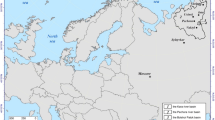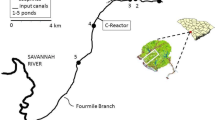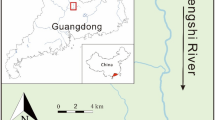Abstract
Metals contamination from mining activities is a persistent problem affecting aquatic ecosystems throughout mining districts in the western USA. The Gold Creek drainage in northern Idaho has a history of mining within its headwaters and contains elevated sediment concentrations of As, Cd, Cu, Pb, and Zn. To determine system-wide impacts of increased metals, we measured concentrations of metals in water, sediment, and benthic macroinvertebrate tissues and related them to whole-body fish tissues and histopathological alterations in native salmonids. Water concentrations were higher than those in reference areas, but were below water quality criteria for protection of aquatic biota for most of the study area. Sediment and benthic macroinvertebrate tissue concentrations for all metals were significantly higher at all sites compared with the reference site. Fish tissues were significantly higher for all metals below mine sites compared with the reference site, but only Cd and Pb were higher in fish tissues in the furthest downstream reach in the Gold Creek Delta. Metals concentrations in benthic macroinvertebrate tissues and fish tissues were strongly correlated, suggesting a transfer of metals through a dietary pathway. The concentrations within sediments and biota were similar to those reported in other studies in which adverse effects to salmonids occurred. We observed histopathological changes in livers of bull trout, including inflammation, necrosis, and pleomorphism. Our study is consistent with other work in which sediment-driven exposure can transfer up the food chain and may cause adverse impacts to higher organisms.







Similar content being viewed by others
References
Allen T, Awasthi A, Rana SVS (2004) Fish chromatophores as biomarkers of arsenic exposure. Environ Biol Fishes 71:7–11
Bergman HL, Dorward-King EJ (eds) (1997) Reassessment of metals criteria for aquatic life protection: priorities for research and implementation. SETAC Pellston Workshop on Reassessment of Metals Criteria for Aquatic Life Protection; 1996 Feb 10–14. SETAC, Pensacola, FL, 114 pp
Bernet D, Schmidt H, Meier W, Burkhardt-Holm P, Wahli T (1999) Histopathology in fish: proposal for a protocol to assess aquatic pollution. J Fish Dis 22:25–34
Buhl KJ, Hamilton SJ (1990) Comparative toxicity of inorganic contaminants released by placer mining to early life stages of salmonids. Ecotoxicol Environ Saf 20:325–342
Cavender TM (1978) Taxonomy and distribution of the bull trout, Salvelinus confluentus (Suckley) from the American Northwest. Calif Fish Game 3:139–174
Chapman GA (1978) Toxicities of cadmium, copper, and zinc to four juvenile stages of Chinook salmon and steelhead. Trans Am Fish Soc 107:841–847
Cockell KA, Bettger WJ (1993) Investigations of the gall bladder pathology associated with dietary exposure to disodium heptahydrate in juvenile rainbow trout (Onchorynchous mykiss). Toxicology 77:233–248
Cockell KA, Hilton JW (1988) Preliminary investigations on the comparative chronic toxicity of four dietary arsenicles to juvenile rainbow trout (Salmo gairdneri R.). Aquat Toxicol 21:518–527
Cockell KA, Hilton JW, Bettger WJ (1991) Chronic toxicity of dietary disodium arsenate heptahydrate to juvenile rainbow trout (Onchorynchus mykiss). Arch Environ Contam Toxicol 31:518–527
Cockell KA, Hilton JW, Bettger WJ (1992) Hepatobiliary and hematological effects of dietary disodium arsenate heptahydrate in juvenile rainbow trout (Onchorynchus mykiss). Comp Biochem Physiol 103C(3):453–458
Downs CC, Jakubowski R, Moran S (2003) Lake Pend Oreille-Clark Fork River fishery research and monitoring: 2002 annual progress report-bull trout redd counts and escapement estimates, 1999–2001. Report to the Avista Corporation by the Idaho Department of Fish and Game, Boise
Eaton JG, McKim JM, Holcombe GW (1978) Metal toxicity to embryos and larvae of seven freshwater fish species. 1. Cadmium. Bull Environ Contam Toxicol 19:95–103
Farag AM, Stansbury MA, Hogstrand C, MacConnell E, Bergman HL (1995) The physiological impairment of free-ranging brown trout exposed to metals in the Clark Fork River, Montana. Can J Fish Aquat Sci 52:2038–2050
Farag AM, Woodward DF, Goldstein JN, Brumbaugh W, Meyer JS (1998) Concentrations of metals associated with mining waste in sediments, biofilm, benthic macroinvertebrates, and fish for the Coeur d’ Alene River basin, Idaho. Arch Environ Contam Toxicol 34:119–127
Farag AM, Woodward DF, Brumbaugh W, Goldstein JN, MacConnell E, Hogstrand C, Barrows FT (1999) Dietary effects of metals-contaminated invertebrates from the Coeur d’Alene River, Idaho, on cutthroat trout. Trans Am Fish Soc 128:578–592
Farag AM, Skaar D, Nimick DA, MacConnell E, Hogstrand C (2003) Characterizing aquatic health using salmonid mortality, physiology, and biomass estimates in streams with elevated concentrations of arsenic, cadmium, copper, lead, and zinc in the Boulder River Watershed, Montana. Trans Am Fish Soc 132:450–467
Farag AM, Nimick DA, Kimball BA, Church SE, Harper DD, Brumbaugh WG (2007) Concentrations of metals in water, sediment, biofilm, benthic macroinvertebrates, and fish in the Boulder River watershed, Montana, and the role of colloids in metal uptake. Arch Environ Contam Toxicol 52:397–409
Frankenberger WT Jr (2001) Environmental chemistry of arsenic. Marcel Dekker, New York, NY, 404 pp
Gauthier C, Couture P, Pyle GC (2006) Metal effects on fathead minnows (Pimephales promelas) under field and laboratory conditions. Ecotoxicol Environ Saf 63:353–364
Ghosh D, Bhattacharya S, Mazumder S (2006) Perturbations in the catfish immune responses by arsenic: Organ and cell specific effects. Comp Biochem Physiol C 143:455–463
Goetz FA (1989) Biology of the bull trout Salvelinus confluentus: a literature review. Willamette National Forest Eugene, OR, 53 pp
Hansen JA, Welsh PG, Lipton J, Cacela D, Dailey AD (2001) The relative sensitivity of bull trout (Salvelinus confluentus) and rainbow trout (Onchorynchous mykiss) to acute copper toxicity. Environ Toxicol Chem 21(1):67–75
Hansen JA, Welsh PG, Lipton J, Suedkamp MJ (2002) The effects of long-term cadmium exposure on the growth and survival of juvenile bull trout (Salvelinus confluentus). Aquat Toxicol 58:165–174
Hansen JA, Lipton J, Welsh PG, Cacela D, MacConnell B (2004) Reduced growth for rainbow trout (Oncorhynchus mykiss) fed a live invertebrate diet pre-exposed to metal-contaminated sediments. Environ Toxicol Chem 23:1902–1911
Ingersoll CG (2007) Expert report on the development and application of sediment quality guidelines to assess the toxicity of metals in sediment. Prepared for US Department of Justice, US Department of the Interior, Office of the Solicitor, 59 pp
Jankong P, Chalhoub C, Kienzl N, Goessler W, Fancesconi KA, Visoottiviseth P (2007) Arsenic accumulation and speciation in freshwater living in arsenic-contaminated waters. Environ Chem 4:11–17
Lage CR, Nayak A, Kim CH (2006) Arsenic ecotoxicology and innate immunity. Integr Comp Biol 46(6):1040–1054
Luoma SN, Rainbow P (2005) Why is metal bioaccumulation so variable? Biodynamics as a unifying concept. Environ Sci Technol 39(7):1921–1931
McGeachy SM, Dixon DG (1990) Effect of temperature on the chronic toxicity of arsenate to rainbow trout (Onchorynchus mykiss). Can J Fish Aquat Sci 47:2228–2234
Pedlar RM, Ptashynski MD, Wautier KG, Evans RE, Baron CL, Klaverkamp JF (2001) The accumulation, distribution, and toxicological effects of dietary arsenic exposure in lake whitefish (Coregonus clupeaformis) and lake trout (Salvelinus namaycush). Comp Biochem Physiol C 131:73–91
Pedlar RM, Ptashynski MD, Evans R, Klaverkamp JF (2002) Toxicological effects of dietary arsenic exposure in lake whitefish (Coregonus clupeaformis). Aquat Toxicol 57:167–189
Pratt KL (1992) A review of bull trout life history. In: Howell PJ, Buchanan DV (eds) Proceedings of the Gearhart Mountain bull trout workshop. American Fisheries Society, Corvallis, Oregon Chapter, pp 5–9
Rainbow PS (1996) Heavy metals in aquatic invertebrates. In: Beyer WN, Heinz GH, Redmon-Norwood AW (eds) Environmental contaminants in wildlife. CRC, Boca Raton, FL, pp 405–426
Rieman BE, Myers DL (1997) Use of redd counts to detect trends in bull trout (Salvelinus confluentus) populations. Conserv Biol 11(4):1015–1018
Sorenson EMB (1991) Metal poisoning in fish. CRC, Boca Raton, FL, 374 pp
Thurow RF, Schill DJ (1996) Comparison of day snorkeling, night snorkeling, and electrofishing to estimate bull trout abundance and size structure in a second-order Idaho Stream. North Am J Fish Manag 16:314–323
USEPA (2006) Water quality standards, federally promulgated water quality standards, 40 CFR131.36. US Government Printing Office, Washington, DC
Vighi M (1981) Lead uptake and release in an experimental trophic chain. Ecotoxicol Environ Saf 5:177–193
Weston RF (2002) Preliminary assessment and site inspection report. Gold Creek Shoshone Silver Mill, Bonner County, ID
Woodward DF, Farag AM, Bergman HL, Delonay AJ, Little EE, Smith CE, Barrows FT (1994) Metals-contaminated benthic invertebrates in the Clark Fork River, Montana: effects on age-0 brown trout and rainbow trout. Can J Fish Aquat Sci 52:1994–2004
Acknowledgements
This research was funded by the US Fish and Wildlife Service Environmental Contaminants Program and the Fish and Wildlife Cooperative Unit at the University of Idaho. We would like to thank Roy Brazzle, Toni Davidson, Scott Deeds, Kate Healy, and Jon Lipke for their help with data collection. We thank Beth MacConnell at the Bozeman Fish Health Center for histopathological analysis and guidance on interpretation. Lastly, we thank Greg Möller and Brian Spears for their reviews and suggestions.
Author information
Authors and Affiliations
Corresponding author
Rights and permissions
About this article
Cite this article
Kiser, T., Hansen, J. & Kennedy, B. Impacts and Pathways of Mine Contaminants to Bull Trout (Salvelinus confluentus) in an Idaho Watershed. Arch Environ Contam Toxicol 59, 301–311 (2010). https://doi.org/10.1007/s00244-009-9457-x
Received:
Accepted:
Published:
Issue Date:
DOI: https://doi.org/10.1007/s00244-009-9457-x




